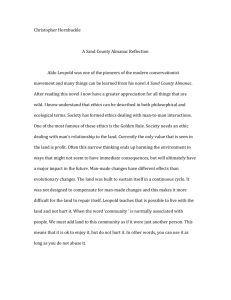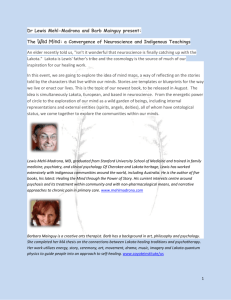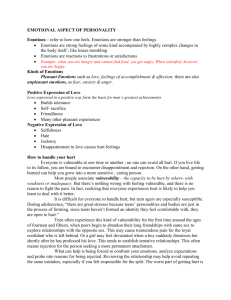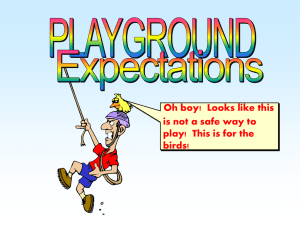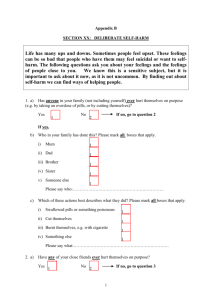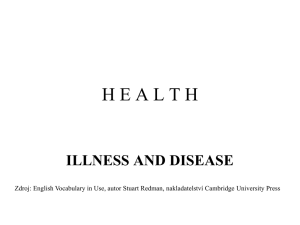OLC Conception of Generalist Practice
advertisement
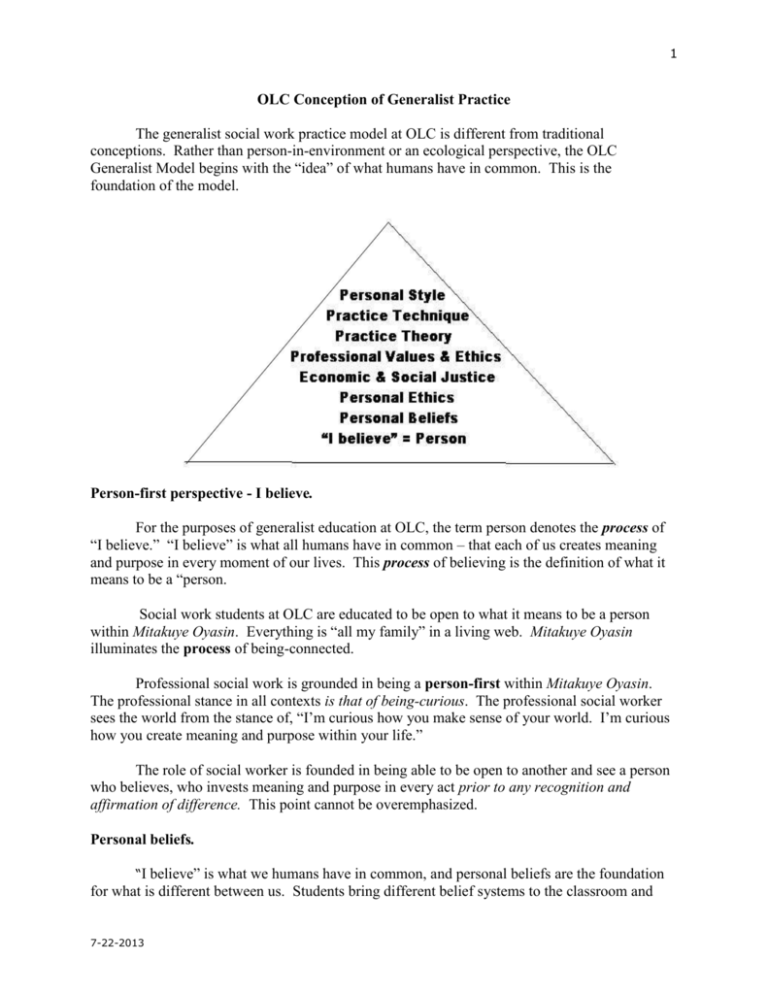
1 OLC Conception of Generalist Practice The generalist social work practice model at OLC is different from traditional conceptions. Rather than person-in-environment or an ecological perspective, the OLC Generalist Model begins with the “idea” of what humans have in common. This is the foundation of the model. Person-first perspective - I believe. For the purposes of generalist education at OLC, the term person denotes the process of “I believe.” “I believe” is what all humans have in common – that each of us creates meaning and purpose in every moment of our lives. This process of believing is the definition of what it means to be a “person. Social work students at OLC are educated to be open to what it means to be a person within Mitakuye Oyasin. Everything is “all my family” in a living web. Mitakuye Oyasin illuminates the process of being-connected. Professional social work is grounded in being a person-first within Mitakuye Oyasin. The professional stance in all contexts is that of being-curious. The professional social worker sees the world from the stance of, “I’m curious how you make sense of your world. I’m curious how you create meaning and purpose within your life.” The role of social worker is founded in being able to be open to another and see a person who believes, who invests meaning and purpose in every act prior to any recognition and affirmation of difference. This point cannot be overemphasized. Personal beliefs. “I believe” is what we humans have in common, and personal beliefs are the foundation for what is different between us. Students bring different belief systems to the classroom and 7-22-2013 2 each is honored. The OLC Generalist Model is open to other worldviews and how personal ethics are constructed within those worldviews. As many students profess a Christian belief in God as a Lakota belief in Tunkasila. However, in line with the college’s mission, the social work program does its best to illuminate and make as clear as possible that the Lakota way is the primary framework within which professional practice is understood As one social work student articulates a Lakota perspective, there is “Taku Skan Skan (an all encompassing energy that exists) as our creator of mother earth and all living things. Tunkasila(pi) exists as the spirits of our ancestors who are called upon with humility to help guide us in a positive way through the realm of Taku Skan Skan.” Everything is inter-related. Everything is sacred. For social workers coming from Lakota culture, all differences are in balance and harmony, in Wo’Lakota. This is the natural way of things. All things are in balance and harmony within the sacred web of relations that are all differences in the world. Wo`Lakota encourages Lakota social work students to affirm the strengths and wisdom that is the core of Lakota culture - our connection to each other and to the Earth. Personal ethics. Upon this understanding of “I believe” and personal beliefs – what is common and different among us - rests the realm of personal ethics. In Western culture personal ethics are different from personal beliefs. However, all personal ethics are grounded in personal beliefs. Personal ethics guide how “I” treat other humans and the earth, how I act. To engage in ethical action is to act from within one’s personal belief system guided by a well-developed set of personal ethics. In Lakota culture, Mitakuye Oyasin assumes an equal relationship between beliefs, ethics and action, that everything is sacred and exists is in Wo’Lakota - in balance and harmony. Mitakuye Oyasin and Wo’Lakota includes Woope Sakowin, the Seven Sacred Laws. Woope Sakowin guides the Lakota social worker in how to be open to the world as it reveals itself in all its relationships. Woope Sakowin is core to assuming the sacred responsibility to live within Mitakuye Oyasin. To act according to Woope Sakowin is a way of honoring being in spiritual relationship with all things. The social worker educated in the OLC Generalist Model learns that honoring being in relationships is based in a basic respect for the worth and dignity of every human being as well as all life forms, regardless of difference. Wacante Oganake Wowaunsila Wowauonihan Wowacintanka Wowahwala 7-22-2013 To help, to share, to give, to be generous. To be compassionate To respect and honor To be patient & tolerant. To be humble and to seek humility. 3 Woohitike Woksape To be guided by ones principles, disciplined, brave, & courageous Understanding and wisdom. A core theme in the Lakota way of life is that of “right action.” Right action is based in you taking personal responsibility for maintaining and deepening Wo`Lakota. Economic and social justice. The fourth dimension of the OLC Generalist Model is the frame of economic and social justice. Once a student starts the process of clarifying and becoming concise about personal beliefs and personal ethics, s/he is ready to broaden his/her perspective and demonstrate that “right action” involves giving back what she has been given - Wacante Oganake. That a person can take the time to get clear on personal beliefs and ethics is a gift from the world dependent upon having the first four of Maslow’s five basic needs sufficiently satisfied. Self-actualization Self-love Love of Others Safety Needs Physiological Needs Physiological Safety Love of Others Self-love Spiritual A Western understanding of how Maslow’s hierarchy of needs can serve as the framework for economic and social justice is as follows. Economic justice occurs when a person’s physiological and safety needs have been enough satisfied. Social justice occurs when a person’s need for the love of others and self-esteem needs have been enough satisfied. Selfactualization, for a social worker, occurs when a person develops the skills, knowledge and values to give back what he or she has been given. This means that a social worker consciously becomes part of the environment that provides access to the means and mechanisms by which other persons can satisfy their first four needs. Within the context of the Lakota culture, the hierarchy is reversed. Wo’Lakota is the natural way of things and exists as a consequence of Maslow’s higher needs. Self-actualization constitutes the spiritual dimension, the foundation of all things. Love of others and self-esteem needs are satisfied within the nurturing environment of this spiritual dimension. Physiological and safety needs are satisfied only when these higher needs are lived through the seven virtues Woope Sakowin, and expressed in Wo’Lakota and Mitakuye Oyasin – are satisfied. By having a bi-cultural understanding of basic needs social workers learn to be “Twoworld Walkers.” The OLC social work student learns to work to provide access to scarce 7-22-2013 4 resources to Lakota persons to satisfy the basic physiological and safety needs - food, shelter, clothing, safe neighborhoods and so on. S/he also learns to be part of strengthening Ti’Ospaye and Ti’Wahe by being competent in Woope Sakowin, being aware of, if not living, the seven sacred virtues and participating in the seven traditional ceremonies that maintain traditional culture. Economic and social injustice exists when difference becomes a mechanism by which scarce resources are unequally distributed – where resources include love and accomplishment as well as food, shelter and clothing. The mechanisms by which these resources are distributed are categories of oppression - sexism, racism, classism, nationalism, religionism, ableism, heterosexism, ageism and parentism. Patterns of being-dissatisfied emerge for persons, families, group’s communities and nations when social and cultural norms view difference as a means to distribute resources. Economic and social justice exists when, emerging from what we all have in common (I believe) difference becomes a mechanism by which to explore, appreciate and perhaps understand the diversity in our world. Scarce resources are equitably distributed to persons regardless of difference. The professional social worker as icheya wicasa has been given the resources to experience his or her vision of Wo`Lakota, balance, peace, and harmony. In so far that the person as social worker engages others as persons, s/he contributes to re-establishing, maintaining and deepening Wo`Lakota within her world; Ti’Ospaye, Ti`Wahe, and Oyate. The OLC social work program seeks to give the student the knowledge, skills and professional values to become a change agent within Ti’Ospaye, Ti`Wahe, and the Oyate. Professional values and ethics. Upon the foundation of “I believe,” personal beliefs and economic and social justice the OLC Generalist Model now opens up the dimension of professional values and ethics as written in the NASW Code of Ethics. Professional ethics emerge from within the above definition of economic and social justice and the Lakota worldview of Mitakuye Oyasin, Wo`Lakota and Woope Sakowin. What is unique to the OLC Generalist Model is that a student is asked to demonstrate how professional ethics and values are founded in personal ethics and beliefs. Distinction is made between belief, opinion and judgment. Belief concerns the nature of reality, opinion concerns something or some act in the world, and judgment concerns the “rightness” of a thing or action. Practice Focus 1. The first practice focus is to identify and help build relationship networks between individuals in natural support systems such as Ti`ospaye (extended family), Ti`wahe (immediate family), work, tribal identity, interest groups, and religious affiliations. 7-22-2013 5 2. The second focus is to assist persons within natural support systems to participate and take leadership roles in more formal structures in their communities, e.g. family resource centers, schools, welfare agencies, work settings, interest groups, religious groups, tribal organizations and community governance groups. 3. Thirdly, this practice focus enables social workers to help other persons to be active in changing the social order of norms and expectations given in policy and law that determine how economic and social resources are distributed. 4. Finally, this practice focus requires the social worker remain open to the world as it reveals itself. For OLC educated social workers, this means consciously grounding professional practice in ones spiritual roots, whatever culture a person comes from, and through these roots that are so wonderfully different, to what humans have in common – we are all persons first, each of us investing meaning and purpose in our lives through the ongoing process of believing in maintenance of Wo`Lakota. Practice theory. Upon the foundation of “I believe,” personal beliefs and ethics, the framework of economic and social justice, and professional values and ethics is built social work practice theory. In the OLC Generalist Model the foundational practice theory is based in Maslow’s theory of human motivation. The primary orientation to human motivation is the strengths perspective. The professional practitioner believes that every person is capable of satisfying their own needs given access to the opportunity to do so. A secondary orientation is found in “I hurt theory, a framework for understanding how a person/client system gets needs met when these needs are chronically unsatisfied. The strengths perspective begins with being able to see another person within the dimension of “I believe” – what we have in common, the “person-first perspective.” From within this dimension the practitioner sees a person with beliefs and values and ethics and opinions – what is different between us. The heart of professional helping is to facilitate a client (system) explore, discover, create, and make connections so that they achieve their goals and actualize their vision of a better world, their dreams. Every client system has historical patterns of needs being-satisfied. These patterns make up a client systems’ strengths and resources. Students in the OLC social work program teach themselves to see the person-first. This “seeing” is based in a basic curiosity about difference – how another person makes meaning, how the client system satisfies their basic needs. This is the core of the strengths perspective. The student learns s/he is part of the environment that provides or withholds access to the opportunity for others to satisfy their basic needs. While Maslow’s work is usually seen to describe individual motivation, it is expanded in the OLCGM to include all sizes of client systems. Whether working with a child, adolescent, adult, group, coalition, organization, 7-22-2013 6 community, tribe, or society, the student learns to see accomplishment and potential and creativity everywhere. The strengths perspective is the primary framework within which to practice and help others to successfully satisfy basic needs. However, no set of needs is satisfied 100% of the time. Balancing patterns of being-satisfied are patterns where basic needs are chronically unsatisfied. These patterns develop over time. When a basic need is unsatisfied for any length of time, the need is experienced as “I hurt.” Chronically unsatisfied needs lead to behaviors that focus on getting rid of personal pain “I hurt.” The person learns to inflict personal pain on oneself and others as the primary means to alleviate its intensity. This is a new need that intensifies over time. Lessening of personal suffering becomes part of getting basic needs satisfied. “I hurt theory” explains the developmental trajectory leading to infliction of “I hurt” on self and other. I hurt theory begins with the definition of the person – “I believe,” and how the environment responds to a person’s basic needs. Person The environment responds to a person’s basic needs. The need can be satisfied, and if the same need arises (e.g. hunger, tiredness, the need for nurturance) time after time and the need is satisfied, then a pattern of being-satisfied develops as foundation for action. When a person experiences a need long enough – and the need is unsatisfied, or satisfied only after a long period of time, then a pattern of being-dissatisfied develops as foundation for action. It is these patterns of being-dissatisfied that form the foundation for “I hurt theory.” When a person’s needs are satisfied in a pattern of being-satisfied, then the foundation for the strengths perspective and empowerment practice, and creating the world exists. The person through the role of social worker can become part of the environment that provides access to the opportunity for others to satisfy their basic needs. When a person’s needs are not satisfied in a pattern, then the person develops another layer – “I hurt.” I hurt theory is most easily understood in a visual image. 7-22-2013 7 I Hurt Theory When experiences of being-dissatisfied become patterns where needs are routinely not met, or satisfaction is routinely delayed, then “I hurt theory” emerges to describe human motivation. However, there is never a dominance of being-satisfied or being-dissatisfied. I hurt theory and the strengths perspective/empowerment practice always commingle, always are interwoven. There is never a black and white perspective framing human motivation. Some patterns of behavior stem from being-satisfied and help create the world. Some patterns of behavior mostly stem from unsatisfied needs in search to get them satisfied. Person. I hurt theory beings with, “I am a person.” Person is understood to be another way of saying “I believe and in so doing invest meaning and purpose in the world.” What all persons have in common is “I believe.” I Hurt. When I have a need that isn’t immediately satisfied, “I’m a person who hurts.” This is where the environment has a determining effect. If there is means to satisfy physiological, then safety, then love, then self-esteem needs, and these means come quickly, then patterns of being-satisfied develop. When satisfaction of a need takes time, and this happens over and over, then patterns of being-dissatisfied emerge and form the basis for what motivates a person in his or her actions. It is the environment, as defined above that satisfies or doesn’t satisfy needs. In an important way, when a person’s basic needs are satisfied, s/he feels visible. When they are unsatisfied, the person feels invisible. The motivation to have ones basic needs satisfied is also a search to be recognized as a person by the environment, deserving of having basic needs satisfied. Wo`Lakota exists for this person. 7-22-2013 8 One of the assumptions of the OLC generalist model is that social workers act from patterns of being satisfied enough to be part of changing the environment. This change takes the form of community provided access to opportunities to satisfy one’s basic needs. Social workers are part of the community providing this access. Resentment. When patterns of being-dissatisfied begin to develop, the person feels resentment towards the perceived origin of being-dissatisfied. Resentment is a very complex concept that requires more development than can happen here. Most simply, resentment has two parts. The first part locates the origin of “I hurt” outside of myself in the world – a caregiver, friend, lover, child, co-worker, mate, group, society or nation. The second part has me inflict my pain on this perceived origin of “I hurt.” In infants this infliction takes the form of crying. It is a generic cry to have a need satisfied. With toddlers infliction of “I hurt” is focused on caregivers. As children grow older this focus becomes more complex and conflicted. As children develop their world grows larger to include school and peer group. More sophisticated mechanisms to inflict “I hurt” on others develop as well. In adults, resentment – locating the origin of “I hurt” and its infliction on others – often has more to do with the need to inflict “I hurt” than any real origin of unsatisfied need. Patterns of being-dissatisfied have become routinized as dominant foundation for acting. A common origin is identified and vilified and common “I hurt” is inflicted. Guilt. When I inflict my “I hurt” on someone else long enough, a new pattern develops – that of guilt. I recognize emotionally that resentment - particularly the act of hurting another person - feels good. It feels good to get rid of “I hurt.” For children younger than eight years or so inflicting personal pain on another is recognized emotionally to be wrong. For older children, adolescents and adults, inflicting my personal pain on another is cognitively understood to be wrong - is not right-action. This recognition generates guilt – the feeling the act of hurting another person is wrong. The act is wrong. A person feels guilt as a consequence of feeling or knowing an act or pattern of acting hurts another, and consequently is judged to be wrong. Shame. My resentment and guilt work together in a loop that generates shame. Over time, as the infant becomes a toddler becomes a child, the bad act of inflicting “I hurt” on another becomes a pattern. My wrong act becomes a pattern of acting that becomes a part of who I am. My doing wrong becomes “I am bad.” I am bad because I continue to inflict “I hurt” on those closest to me even though I know it’s wrong. I could stop, but don’t. Because I choose not to stop I am bad – my character is flawed, I am weak and undisciplined, mean and perhaps evil. I hurt theory is a developmental theory. Throughout individual development the patterns of being-dissatisfied resulting in resentment, guilt and shame are affirmed by the world. The environment of cultural, social and familial norms validates a person developing through infanthood, toddlerhood and childhood in complex patterns of being satisfied and dissatisfied. Children about the age of 8 years old learn to store “I hurt” and inflict it on others in socially acceptable ways. This parallels the child’s development of the ability to engage in if-then thinking; if I do this, then this will likely be the consequence of my action. 7-22-2013 9 Frustration. The next level/stage of “I hurt theory” sees the maelstrom of acute personal pain expressed through resentment, guilt and shame metamorphize into frustration. No longer does a person who hurts need to feel “I hurt” and immediately get rid of the emotion by inflicting it on others. S/he learns to contain personal suffering, to hold it in a reservoir. The reservoir stores “I hurt” as chronic, low intensity general malaise. Patterns of being-dissatisfied are so ingrained and determinant of what is perceived in the world that much personal energy is spent looking for and maintaining ways to get rid of “I hurt” by inflicting it on the world in socially acceptable ways. A person relieves the reservoir of frustration by learning socially acceptable ways of inflicting “I hurt” on others. This is performed in small, controlled, bursts, in drips and drabs of sarcasm, complaining, vocal tonality, body posture, eye contact, facial expression – these and a practical infinity of mechanisms are learned in order to vent in little ways the big reservoir of “I hurt.” The normative and normalizing environment promotes individual development of beingdissatisfied and provides the mechanisms by which to get rid of “I hurt” by inflicting it on others. Socially acceptable ways of getting rid of “I hurt” can be directed outwards on others in the world – resentment, and inwards on oneself – shame. What makes the acts those of frustration rather than resentment and shame is that the person is now responsible for maintaining the reservoir of “I hurt” through consideration of consequences of different actions. A person has learned to regulate infliction of personal pain on the world. For most of us, this reservoir of personal pain stemming from a lifetime of having one’s needs unsatisfied is balanced with patterns of being-satisfied, where we feel accomplished and successful, where we “feel” the interconnectedness of things in our lives. Often a person creates from within the dynamic tension between patterns of being-dissatisfied and patterns of beingsatisfied. Frustration is constant, but we are able to regulate how much pain “I feel” by getting rid of “I hurt” in ways that are socially acceptable. Anger. When “I hurt” builds so that expressing frustration in socially acceptable ways no longer enough alleviates, then the next dimension emerges. This is the dimension of anger. In anger, I just let loose and try and annihilate you with my pain, my “I hurt.” I inflict my personal pain on you, aiming at the heart of your being. I hurt you as effectively as I can, and I feel better. Anger is the mechanism by which I release the terrible pressure of frustration, reservoired “I hurt.” I need the crisis in order to go on. Because the tension involved in feeling frustrated is enough gotten rid of, I am able to feel guilt again, and perhaps some shame. However, unless I find a healthy way to learn to satisfy my basic needs, frustration will build and I will get angry and once again hurt someone. Anger is expressed by groups, organizations, communities, societies and nations as well as individuals. Eruptive rage. The last part of I Hurt Theory is that of eruptive rage. Eruptive rage occurs when I inflict my personal pain on you in such a way that I break the law. Angry yelling is legal. Hitting is not. There is a boundary that the law defines – what is legal and illegal, right and wrong. Acts of anger no longer vent enough “I hurt.” Personal pain is so intense frustration has given over to anger, and anger has given over to eruptive rage. 7-22-2013 10 “I Hurt” theory is a way to understand what motivates persons when basic needs are chronically dissatisfied. When the environment does not offer access to the means to satisfy basic needs, a person, family, group, organization, community and nation moves through the levels until enough attention is gathered to get those needs satisfied. In the OLC Generalist Model, it is the social worker who works within the boundary of client systems, their needs and access to the opportunity to satisfy those needs provided (or not) by the environment. In this way the person or group of persons feels visible. “I hurt theory” is discussed in fairly detailed degree in order for social work students to be able to answer the question, “Why did s/he do that?” When a person (client system of all sizes) acts to get rid of personal pain and inflicts it on self or other, the social work student learns to say, “because s/he hurts!” To develop the ability to say this enables the student to refrain from searching for historical or contextual reasons that another person engages in hurtful behaviors – to tell another person’s story and thereby contribute to their feeling unsatisfied. Once the student realizes it is enough to acknowledge another person hurts, the possibility emerges for a person to tell his or her own story, to enter or continue in the process of healing, be it a momentary hurt or intergenerational trauma and grief. For social workers patterns of chronically unsatisfied needs constitute the dimension of healing. A person develops the skills and knowledge to satisfy his or her basic needs. This healing movement is at root learning to assume personal responsibility for satisfying one’s own needs. Only when this choice is made routine can a person reverse the developmental progression to anger and eruptive rage. Healing involves of moving backwards from eruptive rage, through anger and frustration, through shame, through guilt to resentment. Finally, a person has made healing routine when she is able to say I’m a person who hurts. As new behaviors emerge that are based in being-satisfied, the person has the opportunity to become ever more a part of the environment that provides access to the opportunity to others to satisfy basic needs. For Native peoples, this assumption of personal responsibility for healing and for living a healthy life is an important step to work through intergenerational transmission of trauma and grief. Contact with Western culture resulted in genocide and cultural annihilation that led many Indigenous persons to adopt Western ways. The healing process begins with individual persons learning to satisfy their own needs, and then becoming part of the environment that provides access to the opportunity for others to do the same. For Native cultures to thrive this likely means re-establishing the primacy of the spiritual over physiological needs. Students learn that “healing oneself” and “creating the world” are both steps in the process of personal development and foundation for doing professional social work within Lakota culture. One of the overarching goals of the social work program is to provide students with the knowledge and skills to develop enough self-awareness to not only engage in the 7-22-2013 11 process as part of personal growth, but to learn how to model it as part of creating a better world for the Oyate. Practice technique. The OLC social work program has identified the 6 step, relationship building/problem solving process as the primary practice technique. Use of this practice technique achieves two general practice goals; (1) to practice within the strengths perspective and participate in creating a more just world, and (2) to engage in empowerment practice, being part of the environment that offers access to the opportunity for persons to satisfy their basic needs. This practice technique serves as foundation for all other practice techniques learned with the OLC social work program. No matter how sophisticated or macro systems focused a practice technique is, the 6 step process lies at its foundation. The 6-step relationship-building, problemsolving process is as follows. 1. Step #1 Validate what you see (usually an emotion) a. The practitioner knows it’s time to go to step #2 when a person’s emotion is vented enough. This is signaled by less expression of “I hurt,” but periods of silence, sighs and other signs. 2. Step #2 Get the client (system) to interpret what’s going on leading to the emotion. a. The practitioner knows its time to go to step #3 when the person begins to repeat elements of the story she tells. Relationship building always involves encouraging the client system to tell their story. Part of the skill of relationship building is recognizing when a client system can go no further. 3. Step #3 Have the client (system) brainstorm at least three options for action. a. For each option, have the client (system) explore its consequences. 4. Step #4 Ask the client which option s/he chooses for action. a. If appropriate, role play carrying out the option 5. Step #5 Step #6 Ask the client system if you can follow up to find out what happened. Actually follow-up. Personal style Finally, the OLC Generalist Model has the student become aware of, and eventually use their personal style as the most visible means to create a just world. As part of developing this awareness the student comes to recognize that what humans have in common (I believe) is far more concrete and real than personal style - what is observable in the moment, and in patterns of behavior within moments. Personal style is abstract, changeable, ephemeral and unimportant. “I 7-22-2013 12 believe” and Personal belief is relatively unchanging, concrete, definitive in regards to meaning and purpose, and very important. Nonetheless, personal style is what others see, is the dimension of behaving. Based on all the more concrete and fundamental dimensions, the student learns to act, to behave in ways that reflect professional growth. Personal style is the dimension within which the practitioner creates a presence within the environment that provides access to the opportunity for others to learn to satisfy their own needs, and thereby become part of creating a just world. The OLC generalist model serves as conceptual beginning for “how” social workers approach a practice situation. The final part of this model focuses on building skills, knowledge and values appropriate for social work with diverse client systems. More specific practice methods (founded in the six-step process) are embedded in the roles assumed by beginning social workers. Some examples of these roles include case management, program development, community development, neighborhood and community organizing, client advocacy, legislative advocacy, resource acquisition, mediation and facilitation, group home worker, discharge planning, probation or parole officer, or benefits worker. Regardless of role or specific method used within the role, the generalist model guides “how” to perform and lays out the overall purpose for doing social work – to participate effectively in Wo`Lakota, making the world a harmonious and peaceful place in which to live. For the beginning generalist social worker the question, “why did you do that?” has one answer consisting of five parts. The answer to this question is some combination of (1) Woope Sakowin, (2) culturally sensitive and (if possible) research based practices, (3) theory, (4) professional ethics and (5) supervisor’s practice wisdom. When the student begins to weave these five components to say why she did what she did, the move from natural helper to professional has begun. 7-22-2013

